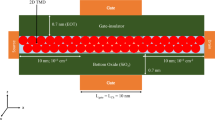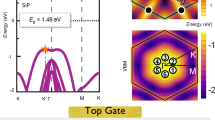Abstract
Two-dimensional (2D) semiconductor crystals can be applied to further increase the efficiency and speed of field-effect transistors. Such transistors are free from some of the adverse effects present in the traditional MOS transistors when their size is reduced. In this study, the model of the transistor MOS structure with the channel made of a 2D-crystal is proposed and its charge properties are investigated. The numerical simulation of such characteristics is carried out within the range of variations of the electrophysical properties of 2D-crystals representative of MoSe2, WS2, WSe2, ZrSe2, HfSe2, and PtTe2. The self-consistent correlation between electrophysical parameters of the structure via the chemical potential is found, and the effect of the potential of the field electrode and the gate insulator’s capacitance on them is demonstrated. The calculations of the steepness of the transfer characteristic and the voltage gain of such a transistor structure demonstrate that, for the channel made from transition metal dichalcogenides (TMD) with the forbidden gap band falling in the range 0.25–2.1 eV, the magnitudes of these parameters can attain 0.1 mA/V and 1000, respectively.






Similar content being viewed by others
REFERENCES
Yoon, Y., Ganapathi, K., and Salahuddin, S., How good can monolayer MoS2 transistors be?, Nano Lett., 2011, vol. 11, pp. 3768–3773.
Wang, Q.H., Kalantar-Zadeh, K., Kis, A., et al., Electronics and optoelectronics of two-dimensional transition metal dichalcogenides, Nat. Nanotechnol., 2012, vol. 7, pp. 699–712.
Mingsheng, X., Tao, L., Minmin, S., and Hongzheng, C., Graphene-like two-dimensional materials, Chem. Rev., 2013, vol. 113, no. 5, pp. 3766–3798.
Radisavljevic, B., Radenovic, A., Brivio, J., et al., Single-layer MoS2 transistors, Nat. Nanotechnol., 2011, vol. 6, pp. 147–150.
Cao, W., Kang, J., Liu, W., and Banerjee, K., A compact current-voltage model for 2D semiconductor based field-effect transistors considering interface traps, mobility degradation, and inefficient doping effect, IEEE Trans. Electron. Dev., 2014, vol. 61, no. 12, pp. 4282–4290.
Jiménez, D., Drift-diffusion model for single layer transition metal dichalcogenide field-effect transistors, Appl. Phys. Lett., 2012, vol. 101, pp. 243501-1–243501-4.
Fuhrer, M.S. and Hone, J., Measurement of mobility in dual-gated MoS2 transistors, Nat. Nanotechnol., 2013, vol. 8, pp. 146–147.
Duan, X., Wang, C., Pan, A., and Duan, X., Two-dimensional transition metal dichalcogenides as atomically thin semiconductors: opportunities and challenges, Chem. Soc. Rev., 2015, vol. 44, no. 24, pp. 8859–8876.
Chhowalla, M., Suk Shin, H., Eda, G., et al., The chemistry of two-dimensional layered transition metal dichalcogenide nanosheets, Nat. Chem., 2013, vol. 5, no. 4, pp. 263–275.
Wang, X., Fan, W., Fan, Z., et al., Substrate modified thermal stability of mono- and few-layer MoS2, Nanoscale, 2018, vol. 10, no. 7, pp. 3540–3546.
Chernozatonskii, L.A. and Artyukh, A.A., Quasi-two-dimensional transition metal dichalcogenides: structure, synthesis, properties, and applications, Phys. Usp., 2018, vol. 61, no. 1, pp. 2–28.
Krivosheeva, A.V., Shaposhnikov, V.L., Borisenko, V.E., et al., Band gap modifications of two-dimensional defected MoS2, Int. J. Nanotechnol., 2015, vol. 12, nos. 8–9, pp. 654–662.
Gusakova, J., Wang, X., Shiau, L.L., et al., Electronic properties of bulk and monolayer TMDs: theoretical study within DFT framework (GVJ-2e method), Phys. Status Solidi A, 2017, vol. 214, no. 12, p. 1700218-1–7.
Krivosheeva, A.V., Shaposhnikov, V.L., Borisenko, V.E., et al., Theoretical study of defect impact on two-dimensional MoS2, J. Semicond., 2015, vol. 36, no. 12, pp. 122002-1–6.
Ilatikhameneh, H., Tan, Y., Novakovic, B., et al., Tunnel field-effect transistors in 2D transition metal dichalcogenide materials, IEEE J. Explor. Solid-State Comput. Dev. Circuits, 2015, vol. 1, pp. 12–18.
Rasmussen, F.A. and Thygesen, K.S., Computational 2D materials database: electronic structure of transition-metal dichalcogenides and oxides, J. Phys. Chem. C, 2015, vol. 119, pp. 13169–13183.
Liu, L., Bala Kumar, S., Ouyang, Y., and Guo, J., Performance limits of monolayer transition metal dichalcogenide transistors, IEEE Trans. Electron Dev., 2011, vol. 58, no. 9, pp. 3042–3047.
Krivosheeva, A.V., Shaposhnikov, V.L., and Bori-senko, V.E., Zone structure and optical properties of molybdenum and tungsten dichalcogenides, Vestn. Fonda Fundam. Issled., 2016, vol. 77, no. 3 (16), pp. 41–48.
Sze, S.M., Physics of Semiconductor Devices, New York: Wiley, 1969.
Zebrev, G.I., Graphene field effect transistors: diffusion-drift theory, in Physics and Applications of Graphene-Theory, Mikhailov, S., London: InTech, 2011, Chap. 23, pp. 476–498.
Luryi, S., Quantum capacitance devices, Appl. Phys. Lett., 1988, vol. 52, pp. 501–503.
Wolfram, S., The Mathematica Book, 5th ed., USA: Wolfram Media, 2003.
Finge, T., Riederer, F., Mueller, M.R., et al., Investigations on field-effect transistors based on two-dimensional materials, Ann. Phys. (Berlin), 2017, vol. 529, no. 11, pp. 1700087-1–10.
Roy, T., Tosun, M., Kang, J.S., et al., Field-effect transistors built from all two-dimensional material components, ACS Nano, 2014, vol. 8, no. 6, pp. 6259–6264.
Tong, X., Ashalley, E., Lin, F., et al., Advances in MoS2-based field effect transistors (FETs), Nano-Micro Lett., 2015, vol. 7, no. 3, pp. 203–218.
Author information
Authors and Affiliations
Corresponding author
Additional information
Translated by G. Levina
Rights and permissions
About this article
Cite this article
Makovskaya, T.I., Danilyuk, A.L., Krivosheeva, A.V. et al. Charge Properties of the MOS Transistor Structure with the Channel Made from a Two-Dimensional Crystal. Russ Microelectron 49, 507–515 (2020). https://doi.org/10.1134/S1063739720070069
Received:
Revised:
Accepted:
Published:
Issue Date:
DOI: https://doi.org/10.1134/S1063739720070069




